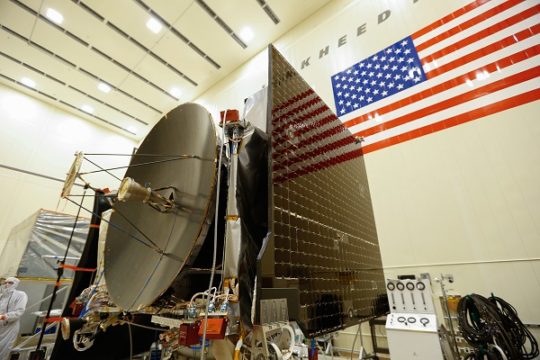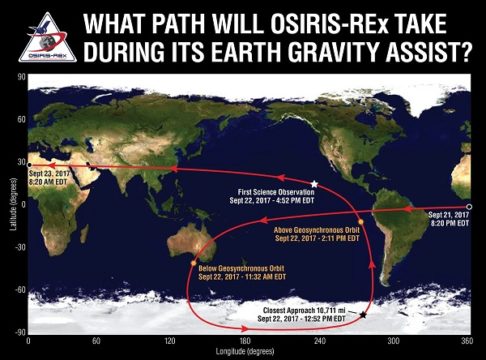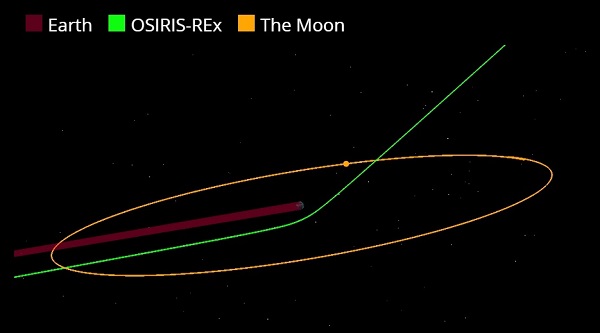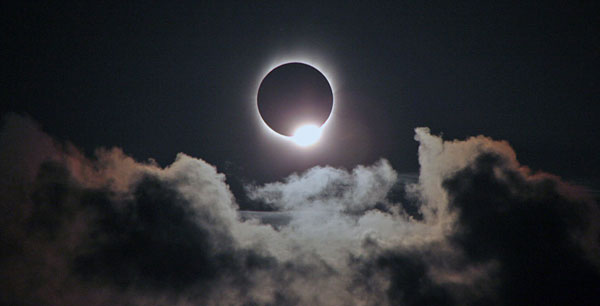NASA's ambitious Osiris-REX asteroid sample return mission swings by Earth this Friday for a gravity assist en route to asteroid 101955 Bennu.

NASA/GSFC/University of Arizona
An old friend pays Earth a brief visit Friday, as NASA's OSIRIS-REX asteroid sampling mission swings by Earth on September 22nd.
Launched on September 8, 2016, this craft is bound for asteroid 101955 Bennu, due to arrive in the summer of 2018.
To boost its orbit beyond Earth's, Osiris-REX is swinging by our planet for a gravity assist. Closest approach occurs at 12:52 p.m. EDT (16:52 UT) at an altitude of 11,000 miles (17,000 km) over Antarctica. That's about half the distance to geosynchronous orbit.
At just over 20 feet long (with solar panels deployed), Osiris-REX will stay below naked eye visibility. However, it should reach 10th magnitude as it crosses over eastern Australia (see the map below) — visible through a well-pointed, decent-sized telescope. The spacecraft will be moving at 8.5 km per second (19,000 mph) at closest approach.
“The Earth Gravity Assist provides an excellent opportunity to test the alignment and calibration of the Osiris-REX cameras and spectrometers against the well-characterized Earth and Moon,” says Jason Dworkin (NASA Goddard). “The science involved will improve our understanding of how the instruments perform in space.”

NASA / Osiris-REX
The spacecraft's Visible and Infrared Spectrometer (OVIRS), Thermal and Emission Spectrometer (OTES) and Camera Suite (OCAMS) instruments will image Earth and the Moon during the flyby. We should see some interesting images on the Earth-Moon pair reminiscent of other spacecraft flybys in the past.
On to Bennu
The plan is for Osiris-REX to rendezvous with asteroid Bennu in August 2018, where it will carry out and execute the science and acquisition phase of its mission. Already, the team has been preparing for the approach to Bennu, using the spacecraft's MapCam imager to scout for possible Earth Trojans near the L4 and L5 Lagrange points. Osiris-REX hasn't located any Earth-Trojans yet, though it did spy asteroid 12 Victoria zipping across the MapCam imager's field of view on February 11th, proof that such a discovery is possible.

NASA / Goddard / Univ. of Arizona
“Osiris-REX will approach Bennu next August and use its instruments to characterize the asteroid physically and chemically,” says Dworkin. “This will allow the science and engineering team to select the best site to collect a sample of the surface in July 2020.”
The mission will climax with the spacecraft's collection of a surface sample. The Touch and Go Sample Acquisition Mechanism (TAGSAM) arm will reach out and use a burst of nitrogen gas to blow small particles into a collection chamber. The spacecraft will return to Earth on September 24, 2023, when its Sample Return Capsule reenters over the Utah Test and Training Range for recovery.
101955 Bennu is in a carbonaceous asteroid in a 1.2-year orbit around the Sun. It's about 550 meters (1,800 feet) in diameter. The asteroid's orbit is inclined 6° relative to Earth's path around the Sun.
Bennu was named after a bird from Egyptian mythology during the Planetary Society's “Name that Asteroid!” contest in 2012. Discovered by the LINEAR project on September 11th, 1999, Bennu has a small (1-in-2,700) chance of impacting the Earth in the late 22nd century.
This week's flyby will give the spacecraft the necessary kick to get it into the proper orbit — see the video below to watch how it works.
Asteroid Samplers
The mission has company in the asteroid sample collection game. The Japanese craft Hayabusa 2, launched in December 2014, will arrive at its destination asteroid 162173 Ryugu in July 2018. After grabbing a surface sample, it will arrive back at Earth in December 2020.

NASA / Osiris-REX
Spotting Osiris-REX
The Target Asteroids! Citizen Science program is running a campaign to image Osiris-REX as it races past the Earth this week. The Large Binocular Telescope based on Mount Graham in Arizona already captured a view of the fleeting spacecraft on September 2 from seven million miles (0.08 AU) distant:

JAXA will also work with the mission team, the Japan Public Observatory and the Planetary Society of Japan to obtain images of the spacecraft from Japan, shortly after closest approach on Friday. The best views will come as the spacecraft passes over the eastern half of Australia in the early dawn hours on Friday, September 22nd, about an hour prior to closest Earth approach over Antarctica. The Desert Fireball Network based out of Perth, Australia also plans to mobilize observers across the continent in an effort to catch Osiris-REX during the flyby maneuver.

Osiris-REX / Twitter
Chris Peat's Heavens-Above website has a link dedicated to the event, which will automatically generate minute-to-minute coordinates for your set location. From Auckland, New Zealand, for example, Osiris-REX will be passing through the constellation Grus, the Crane, about an hour prior to closest approach, moving at an apparent 30' (the diameter of a full Moon) per minute.

NASA / Osiris-REX
Another alternative is to use JPL Horizons Ephemeris Generator to calculate a range of right ascension and declination positions for Osiris-REX based on your observing location. As with very close passes of near Earth asteroids, parallax for ground based observers and deflection of the object by Earth's gravity both play a significant role, often foiling desktop planetarium programs that fail to take these into account.
Hunting for Osiris-REX will be similar to tracking down satellites fainter than the naked eye limit. A good strategy is to simply note the time on a Heavens-Above star chart when the spacecraft is set to pass a bright star, aim a telescope at the star with a low power wide field of view, then sit and watch in an “ambush” as Osiris-REX drifts by.
Bob King describes a similar quest this week: tracking down satellites in geosynchronous orbit.
Clouded out, or simply live in the wrong hemisphere? NASA TV is carrying live media interviews during September 22nd's flyby starting at 6:30 a.m. EDT. The Osiris-REX team is also encouraging the public to simply tweet photos of themselves waving to the spacecraft to hashtag #HelloOsirisREX (the mission is @OsirisREX on Twitter) or on Instagram as @Osiris_REX. Be sure to say hello — next time it visits Earth, it'll be with samples of an asteroid in hand.
 4
4









Comments
Curiositas
September 21, 2017 at 10:10 am
How fast will it be going after the assist?
You must be logged in to post a comment.
David DickinsonPost Author
September 21, 2017 at 11:58 am
To clarify: the quoted "8.5 km per second" speed is relative to the Earth, post gravity assist; Osiris-REX's speed relative to the Earth on approach pre-flyby is about 6 km per second. See: https://www.asteroidmission.org/where-is-the-spacecraft/
You must be logged in to post a comment.
Sorsor_7
September 22, 2017 at 2:17 am
So will North America miss out on the flyby? I live in Colorado which isnt along the path.
You must be logged in to post a comment.
David DickinsonPost Author
September 22, 2017 at 12:23 pm
Correct... for some reason, spacecraft flybys always seem to favor Antarctica and the southern Pacific ocean...
You must be logged in to post a comment.
You must be logged in to post a comment.